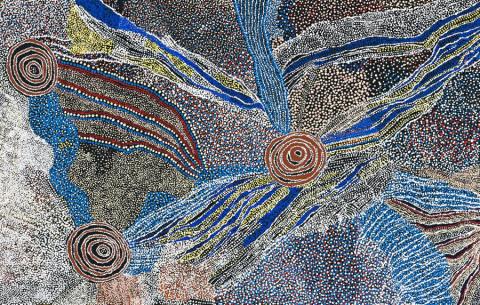ROCKHOLES AND COUNTRY NEAR THE OLGAS, 2006
BILL WHISKEY TJAPALTJARRI
synthetic polymer paint on linen
152.0 x 238.0 cm
inscribed verso: artist's name, size, title and Watiyawanu Artists of Amunturrngu cat. 81-06095
Watiyawanu Artists of Amunturrngu, Mount Leibig
Japingka Gallery, Fremantle
Private collection, Sydney
This painting is accompanied by a certificate of authenticity from Japingka Gallery which states in part: 'Bill has painted the country and rockholes around Ayers Rock. This painting has been created from an aerial perspective, in the tradition of ancient sand drawings. The term 'country' as used by indigenous Australians refers to the spirits that reside in location as well as the landscape itself.'
Raised until his teenage years upon the traditional lands of his family, Bill Whiskey's childhood was that of the nomadic hunter. For the majority of his adult life he worked at Areyonga Community before moving his family to Haasts Bluff and finally settling at an outstation near Amunturrngu.
In his obituary to the artist, Sasha Grishin described Bill Whiskey as 'agile and of small stature, he had a broad flowing bear for which he gained the white man's nickname 'Bill Whiskery'. This soon became abbreviated to Bill Whiskey, giving this teetotaller and non-smoking Pitjantjatjara man a certain bohemian air'.1 It was at the Watiyawanu Artists cooperative at Amunturrngu outstation that Bill Whiskey first observed artists at work on canvas, an occupation to which he was compellingly drawn.
Almost immediately recognised as a painter of significant abilities, prior to working on canvas Bill Whiskey Tjapaltjarri had for many years produced elaborately painted spears and clubs. Covered in delicate and tightly worked dots, the decorated objects are unmistakable examples of Whiskey's hand. Born at Pirupa Alka, located some 130k south of the Olgas, Bill Whiskey's painting deals almost exclusively with the ancestral white cockatoo story associated with the country of his birth. Interestingly it is not a story for which specific iconography was already in use with there being no current evidence of the story having been painted by other members of the Pitjantjatjara people. Rather Bill Whiskey devised a compositional structure replete with roundels and broad sweeping fields of colour which is clearly embedded within the general conventions of Western Desert dot painting.
The resulting paintings, all homage to the country of the artist's birth, operate both as brilliant chromatic landscapes complete with rock pools and the underground watercourses that feed them and as abstract forms charged with symbolic meaning. Describing a landscape formed in battle, Bill Whiskey related the ancestral mythology to Sasha Grishin as focussing on 'three birds - the white cockatoo, his friend the eagle their adversary, the crow... The white cockatoo was hunting one day for witchetty grubs when it was attacked by the marauding crow, which was intent on taking the witchetty grubs for itself. A terrible battle followed in which the two birds crashed to earth several times creating shallow indentations in the ground that became waterholes... But the cockatoo's wings had been badly damaged in the fight and it could no longer fly. The grounded bird can be seen today in form of a large white rock located in a small, natural 'amphitheatre' which is created by sweeping its wings. Around the area are strewn much smaller white rocks that represent the feathers that were scattered during the battle. When the eagle saw what had happened to its friend the cockatoo, it brought pieces of kangaroo meat for the grounded bird to eat. The cockatoo was able to drink from the surrounding rock pools and it remains at this sacred site today.'2
1. 'Bill Whiskey Tjapaltjarri' in Australian Aboriginal Art, Issue 1, March/April/May 2009, p. 163
2. ibid. p. 165
MERRYN SCHRIEVER
